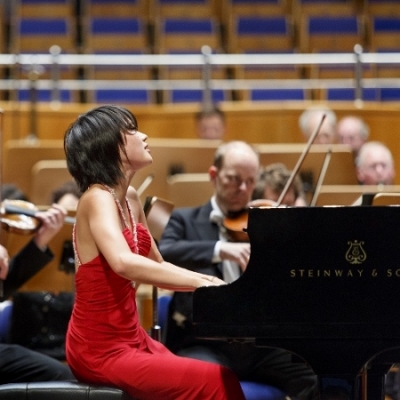Performance in Jerusalem Elevates Wang
The Israel Philharmonic Orchestra, our prime cultural ambassador, has just returned from a most successful tour to China and Singapore. At first glance, this current concert, which featured concertos by Vivaldi and Mozart and a symphony by Saint-Saëns, did not appear to be too challenging. However on closer reflection it afforded the audience a fascinating look as to how the concerto form evolved from baroque to classical.
Vivaldi's Concerto for 3 violins with soloists Semion Gavrikov, Dumitru Pocitari and Asaf Maoz followed the baroque concerto format in which the roles of orchestra and solo are equivalent or in which the solo is predominant.
This was followed by Mozart's piano concerto no. 9 in E flat, K291. In his earlier ventures into the piano concerto oeuvre, Mozart followed the same pattern as his baroque predecessors, Bach and Vivaldi. This E-Flat piano concerto, however, represents a landmark in this genre and a real musical turning point. Composed when he was 25, for the first time in the concerto literature, we have a richly developed relationship between soloist and orchestra. They are now equal partners. The interruption of the orchestra after the first six measures by the piano was so revolutionary that Mozart himself never repeated it, a task which was left to Beethoven and Brahms.
The soloist was glamorous Chinese pianist, Yuja Wang, 29, who made her stage entrance in a stunning halter neck silver Lurex evening gown. She gave an incandescent performance of this masterful work.
This was the first time I heard her in this hallmark Mozart concerto. She gave a nuanced, beguiling, magisterial performance which was full of sensitivity and elegance. Especially impressive was her deep introspective account of the slow second movement, the mark of a true great artist where she blended in beautifully with the orchestra. This mature performance belied her age. By virtue of this tour de force, Yuja Wang now joins the ranks of the great consummate Mozartians.
The audience was privileged to hear three encores, including Vincent Youmans Tea for Two arranged for piano by Art Tatum. This was followed by the ferociously difficult version of Mozart's ever popular Rondo Alla Turca K331 by Arcadi Volodos and Fazil Say. Here Ms Wang played the melody and counter melody with her right hand, and the chords and other intricate passages with the left. The final encore ended on a more subdued note, a sublime account of Sgambati's piano transcription of the Dance of the Blessed Spirits from Gluck's Orfeo and Euridice.
After intermission, under the direction of its long-time music director, Zubin Mehta, the IPO gave an inspired, incisive and colorful account of the Symphony no. 3 ("Organ"), one of the crowning glories of Saint-Saens prodigious musical life.
This symphony is also a trailblazer as it was one of the first to include an organ as a major orchestral component. Saint-Saëns was himself an accomplished organist; Liszt called him "the greatest organist in the world". Besides his music activities as conductor, composer and organist, he was a real polymath, an author with broad knowledge of mathematics, philosophy and astronomy.
The symphony is essentially in two parts each divided into two movements. The inexorable harmonic sweep in the first movement with the beautiful dialogue between organ and strings was most dramatic. Noteworthy was the last movement with the resonant choral blasts of the organ followed by the development of the theme firstly by strings and then joined by piano duettists. Throughout the work, the organ and the piano are not treated as solo instruments but as members of the full ensemble. From his first restrained and understated entrance, to the sonic chords of the last movement, organist Alexander Gorin merged in perfectly with the orchestra.
Zubin Mehta drew out the highlights of this great symphony with unbridled enthusiasm and energy. All the fine and intricate details of the score came through brilliantly.








Comments